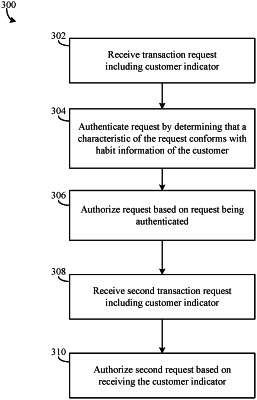| CPC G06Q 20/401 (2013.01) [G06Q 20/40 (2013.01); G06Q 20/409 (2013.01); G06Q 20/40145 (2013.01); G06Q 20/34 (2013.01)] | 20 Claims |

|
1. A financial institution computing system comprising:
a customer database configured to store information for a customer, the information comprising habit information of the customer and a customer indicator of the customer; and
a transaction circuit configured to:
receive, from a first point-of-sale (POS) terminal at a first location, a habitual transaction request including the customer indicator, wherein the habitual transaction request is a first type of transaction to be authorized based on the habit information of the customer and the customer indicator;
identify characteristics of the habitual transaction request, wherein the characteristics comprise a first geographic location and at least one of a transaction amount or a type of merchant;
identify, utilizing the customer indicator, the habit information of the customer stored in the customer database;
authenticate the habitual transaction request based on the characteristics of the habitual transaction request conforming with the habit information of the customer;
in response to authenticating the habitual transaction request, authorize the habitual transaction request;
receive, from a second POS terminal at a second location, a non-habitual transaction request including the customer indicator, wherein the non-habitual transaction request is a second type of transaction to be authorized based on the customer indicator with no other information from the customer;
determine that the customer is active, and the customer indicator is approved to conduct a non-habitual transaction based on the habitual transaction request being authenticated using the habit information at the first POS terminal;
authorize the non-habitual transaction request based on the determination that the customer is active, and the customer indicator is approved to conduct the non-habitual transaction based on the habitual transaction request being authenticated using the habit information at the first POS terminal;
transmit a confirmation to the second POS terminal used to initiate the non-habitual transaction request and indicating the non-habitual transaction request was authorized; and
wherein the habitual transaction request and the non-habitual transaction request are both initiated without the customer presenting a payment card or a payment device.
|